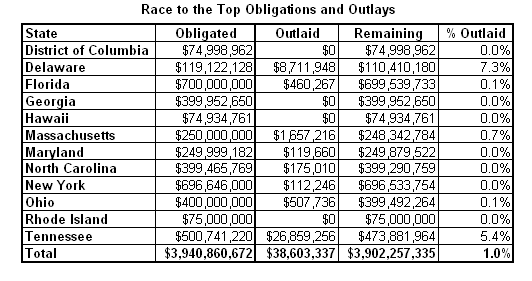State Progress on Race to the Top
Blog Post
Feb. 21, 2011
Late last August, U.S. Secretary of Education Arne Duncan announced ten winners of the second round of the Race to the Top grant competition. Race to the Top—a program enacted in the American Recovery and Reinvestment Act—provided $4.0 billion in three-year competitive grants to states to implement education reform strategies. A total of 11 states and the District of Columbia received Race to the Top (RttT) grants in that initial round of funding. This means that states have had between 6 and 11 months to implement their grant proposals thus far. What is their progress?
Based on reports from the U.S. Department of Education, states have been slow to spend their RttT funds. In total, only $38.6 million, or 1.0 percent, of the RttT grants have been drawn down. Unsurprisingly, Tennessee and Delaware, the two states to receive funds in March 2010 from the first round of grants, have drawn down the highest percentage of their funds. As of February 11th, Delaware had drawn down $8.7 million, or 7.3 percent, of its $119.1 million grant and Tennessee had drawn down $26.9 million, or 5.4 percent of its $500.7 million grant. However, these states are nearly one year into their three-year grants, meaning that they will have to spend their funds much more quickly over the next two years to spend down their grants entirely.

The other nine states and the District of Columbia have drawn down very small amounts of their funds so far. Of this group, Massachusetts has drawn the most $1.6 million, or 0.7 percent, of its $250 million grant. Ohio and Florida have both drawn down about half of a million, or roughly 0.1 percent of their grants. And Georgia, Hawaii, Rhode Island, and the District of Columbia have not drawn down any funds. This does not necessarily mean that they have not begun spending RttT funds, but it does mean that they have not yet submitted a request for reimbursement to the federal government for any RttT related expenses.
In all, it seems reasonable that many states are just beginning to draw down funds for their RttT grants. In most cases, states had a lengthy planning period before major activities began which included hiring staff and project managers to implement their grant proposals, finding vendors for the new data and support services required in the grants, and confirming district participation in the plan. Similarly, newly elected governors in some states have pushed back on their RttT plans, slowing progress. And the worsening economic situation in some states has further affected that planning.
Where will states go from here? The majority of states have about two and a half years to spend down the remainder of their grants – 99 percent or more of their original awards in most cases. Spending will likely ramp up in the coming months, especially as vendors begin work and participating school districts begin more aggressive implementation during the start of the 2011-12 school year.
Check back with Ed Money Watch for more updates.